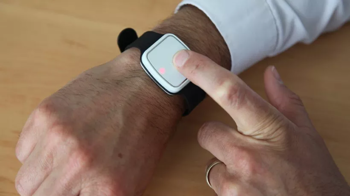The transition from analogue to digital telecare – Why is it important?
The transition from analogue to digital telecare is urgent for the technology enabled care sector and the millions of adults who rely on digital telecare.
You are probably aware of the digital switchover or have heard about it in some capacity. The digital switchover will impact everyone in some way across different industries and sectors. You might have been aware of the switchover for some time or have learnt more about it recently following Openreach’s announcement of their revised digital switchover deadline.
Despite Openreach’s delay, the analogue to digital transition will result in all analogue telephone services being switched off meaning the UK’s telecoms infrastructure will be upgraded to digital connectivity.
- Analogue vs Digital telecare – What is the difference?
- Analogue Vs Digital Telecare – Why is the digital transition important?
- What are the challenges of implementing digital telecare?
- Analogue to Digital Telecare Programme – What do you need to know?
- Analogue Vs Digital Telecare – How can Access Assure help?
- Analogue vs Digital Telecare – Summarising the importance of the transition
Whilst most providers are still working towards the original deadline of switching over by January 2027, we want to ensure you fully understand why being prepared for the switchover is critical and must be completed well to enable individuals to continue living safely and independently at home.
Whether you work for a local authority or are a community member, you are probably wondering what makes a good telecare service and what they should offer when transitioning to digital telecare. You might also be eager to understand how to be best prepared to cause as little disruption as possible. Or you might want to know more about digital telecare in general and what the impacts of Openreach’s delay will mean to determine which telecare providers are offering the best support for you and your community.
At Access Technology Enabled Care (TEC) we want to make sure all communities are prepared for the digital switchover as it is more than a technological upgrade, it’s a fundamental shift to enable new models of service delivery to deliver better proactive and preventative care.
This article will explain all there is to know about what the analogue to digital telecare switch means including the latest updates, and despite delays why it is important to act now to ensure all vulnerable individuals who rely on telecare devices are kept safe and are not at risk of being disconnected.

Analogue vs Digital telecare – What is the difference?
Ultimately both analogue telecare and digital telecare aim to provide care from a distance to help vulnerable people live safer and more independently in their own homes.
There are currently around 1.7 million vulnerable people who rely on telecare services in the UK and many analogue telecare alarm services are becoming less and less reliable. Many have seen a rise in failed alarm call attempts with one provider reporting a failure rate of 11.5% for the first alarm attempt, and unfortunately, these numbers are continuing to rise. So to overcome this, the need to transform digitally is crucial.
How does analogue telecare work?
Analogue telecare as we know it today, before any switchovers, tends to work as follows:
- The end-user will have either alarms, motion sensors, or both
- These sensors and alarms will be connected wirelessly to a controller device connected via an analogue phone line
- When an alarm or sensor goes off a signal will be sent via the analogue phone line to the Public Switch Telephone Network (PSTN) to an alarm receiving centre (ARC)
- Here the signal will be connected to an agent where the next call to action will be decided
How does digital telecare work?
Typically analogue telecare devices are designed to send voice calls over the PSTN network. Often when analogue devices try to connect with an ARC via a digital network, emergency calls can be corrupted and fail to connect.
Digital telecare therefore offers the solution to this problem, and with the Public Switched Telephone Network (PSTN) being switched off for the majority of providers by January 202, the move to go digital is imminent.
To make telecare services more reliable, digital telecare services will replace the PSTN Network with a new system voice-over internet protocol (an ALL-IP digital solution). This means that telecare emergency calls will no longer be received via traditional analogue methods and instead they will rely on data packets being sent over the digital network. Many companies will have their name for it, but one of the biggest and most known currently is BT Digital Voice.
With the PSTN switching off for the majority of providers in 2027, a collaborative approach is needed across different sectors and organisations to be better prepared, especially for more vulnerable individuals across health and social care as well as housing.
Digital telecare services are vital therefore to enable care service delivery models to shift from reactive to preventative to delay future care needs, increase independence, but equally act as a lifeline when needed. The switchover is creating a new basis for the next generation of telecare therefore offering more personalised and preventative care.

Analogue Vs Digital Telecare – Why is the digital transition important?
The transition to digital telecare is important as ultimately many vulnerable telecare users are at risk of losing their daily protection when telephone lines go digital.
Currently many telecare providers use analogue equipment and these devices will no longer be compatible or perform as reliably when the digital telecare switchover takes place.
It is essential all telecare providers digitally transform their service to ensure they have the best continuity of care ready for when the switchover takes place. Policies regarding the analogue to digital telecare switchover have to be considered during the migration to ensure that the individual is at the heart of every decision being made so no one is left without the level of connectivity, care, and support needed.
Digital telecare and care technology in general involves providing arrangements for people to manage both long and short-term conditions more effectively in their own homes. This helps put people in control of their health and wellbeing and increases their independence to reduce pressures on the NHS and care homes.
Here through implementing digital telecare in your local community, you can help individuals have a better quality of life by reducing hospital admissions and readmissions. This, in turn, helps to reduce hospital discharge delays as the data collected with digital telecare creates actionable insights to provide better timely support to the individual.
For local authorities digital telecare offers the ability to control devices remotely meaning home visits become less necessary. This reduces costs allowing funding to be spent elsewhere to improve outcomes further.
Some digital telecare services can also set up different kinds of alerts so that different key holders can step in depending on the severity of a situation. This helps to reduce the reliance on healthcare, emergency services, and telecare providers for less severe issues. These cost savings can then help to offset the initial transition to digital telecare, which depending on the size of a local authority could be very expensive initially.
Transitioning to digital telecare therefore is important as it offers both the end-user and their families reassurance that they will be provided the best and most appropriate care and support regardless of their care needs. The more reliable service compared to analogue telecare will mean there will no longer be failed emergency calls, so they will receive the care they need when they need it.
Transition from analogue to digital telecare – What do we know so far?
As discussed above, Openreach has announced recently they have revised their deadline for the digital switchover from the end of December 2025 to the end of January 2027. It is hoped the revised deadline will enable the migration to digital to be done well so those who rely on telecare services have a reliable service, especially following the pause on the switchover at the end of last year after several incidents where telecare devices stopped working.
Here Openreach wants to ensure that the extra time will allow for improvements to be made to better protect vulnerable customers and those with additional needs which includes telecare users.
Howard Watson, Chief Security and Networks Officer, BT Group, said:
The urgency for switching customers onto digital services grows by the day because the 40-year-old analogue landline technology is increasingly fragile. Managing customer migrations from analogue to digital as quickly and smoothly as possible, while making the necessary provisions for those customers with additional needs, including telecare users, is critically important.
Our priority remains doing this safely and the work we’re doing with our peers, local authorities, telecare providers and key Government organisations is key. But more needs to be done and we need all local authorities and telecare providers to share with us the phone lines where they know there’s a telecare user.
Digital Switchover Delay – What does this mean?
For anyone in the industry, Openreach announcing a delay in the deadline has not come as a surprise, especially as it follows incidents at the end of December last year and the UK Government’s update in August 2023 declaring that there has not been the expected acceleration in the number of telecare users being migrated to digital.
It was expected in the UK Government’s report that more telecare users would be migrated over in 2024 and 2025 than first envisaged. Openreach wanted to avoid this rush to ensure that the switchover is completed well to keep everyone safe and have the digital connectivity they require.
The summer report also declared that the variations in the digital maturity of services were also making migrations difficult and the availability to finance upgrades and replace equipment was increasingly getting difficult, especially in sheltered housing.
Despite the delay, it is being echoed by all providers that it doesn’t mean organisations put the transition on hold, instead it is allowing us more time to do it correctly, efficiently, and safely.
With local authorities making up 70% of telecare service providers, the UK Government have encouraged local authorities to review and follow the LGA’s switchover checklist to ensure their community is fully prepared so end-users can experience the switchover with minimal disruption.
It has also been suggested that care providers identify the equipment and systems they have which operate or are connected to a telephone line to create an audit ready to discuss their switchover with their equipment providers or suppliers. Being better prepared allows time for care providers to notify their end-users so they are aware of why it is happening and what it will mean for them.
Currently, there is very little awareness from telecare users that this switchover is happening, it is important they are aware and understand so the changes can happen in a reasonable timeframe. With more and more publicity about Openreach’s delay, now is an important time to have conversations with telecare providers to see what your next steps are to ensure an effective and strategic plan is in place that best accommodates your community’s needs.
With an estimated half a million telecare devices being used in a range of care homes, supported housing, and sheltered living arrangements, the switchover must happen as smooth as possible. The rest of this article will now discuss the challenges your care providers and local authorities could face during the switchover and how best to overcome them.
What are the challenges of implementing digital telecare?
When done correctly the transition from analogue to digital telecare can be seamless. Following guidelines and policies is vital to deliver digital telecare that is reliable, safe, and cyber secure. For this to happen all organisations need to be aware of the challenges that can occur including the challenges providing telecare to older adults and how to overcome them for the best outcomes.
1. Data Protection
One of the biggest challenges when transitioning to digital telecare is data protection. Unlike analogue telecare systems, digital telecare collects a lot more data to identify day-to-day routines and forecast when individuals may need more support more accurately. With that in mind, end-users' data must be protected thoroughly.
To make sure that is the case, investing in digital telecare operating with cloud systems is best. Here using a digital telecare service connected with a cloud-based system makes sure that only authorised users can access certain levels of data stored in the cloud. That way end-users can feel more reassured that not only will they receive the right level of care when they need it, no personal information will be at risk of being leaked or at risk of being used maliciously.
2. Regulations
Another challenge when transitioning to digital telecare which local authorities will need to be aware of and keep up-to-date with is regulation changes. This is because as technology continues to advance, regulations may become outdated. It is important therefore when developing your digital transformation plan, you must be aware of external factors you cannot control and plan how these risks will be managed and mitigated.
3. Risk to service users
A major concern for end-users of telecare currently is how will the transition impact them. To prevent this you need your local authority to reassure these end-users that the transition will be seamless and only impact them positively. To do this you need to be prepared when there might be technical difficulties and how to overcome them.
In Scotland’s transition to digital telecare for example, there have been 12 areas where service users’ alarms have been deactivated or lost their functionality with no notice. Some transitioned successfully, however others did not and were left in that state.
All end-users must be notified when their switchover will take place and are consistently notified if there are any connectivity issues during the transition.
4. Cost
One challenge that could be huge for some local authorities is the cost implication of the transition. Most local authorities will be required to replace the old alarms with a new GSM (Global System for Mobile Communication) device.
To make best use of your resources you need to be aware of the number of GSM boxes and SIM cards that will be needed initially to be prepared for the increase in budget that might be needed. Through planning this effectively, every individual who needs it will have the resources they need.
Planning for every step and challenge which could occur when developing your transition plan is essential to prevent major disruption. Every decision should benefit the end-users. If a challenge occurs then contingency plans should be in place and end-users must be notified so there is no confusion.
Through being fully prepared and aware of challenges that could arise and how to overcome them your local authority will be more open to new digital opportunities which will provide better person-centred care for your community.
Contact us to learn more about our Digital Telecare solution
Analogue to Digital Telecare Programme – What do you need to know?
For you to be best prepared for the digital switchover following guidelines and analogue to digital telecare policies is crucial.
TSA, the voice of Technology Enabled Care, has released a checklist which buyers and commissioners should follow to ensure the transition is seamless. Some of the most important things from the checklist includes:
- Requirement Consensus – Stakeholders must review their desired outcomes to ensure they work to satisfy the IT, Security and Health and Safety Teams
- Soft Market Testing – Buyers and commissioners must explore what is available on the market to understand what digital telecare company will best suit their local authority’s needs
- Procurement routes – Local authorities need to evaluate how best to procure the digital telecare services they will provide whether it is a static or a dynamic purchasing framework (DPS)
- Digital interoperability – Local authorities should be aware of what level of interoperability they need
- Alarm connectivity – Local authorities need to check the capabilities of different digital telecare with and without SIM cards and how that will impact their community
- Quality Standards Framework (QSF) – TSA recommend that commissioners make it mandatory for organisations involved into the end-to-end delivery of technology enabled care to be certified by TEC Quality according to the Quality Standards Framework
- KPIS – all local authorities need to be sure on what their KPIs are and that they follow the standard QSF

Analogue Vs Digital Telecare – How can Access Technology Enabled Care (TEC) help?
Like previously discussed transitioning to digital telecare offers a shift to a more preventative care approach.
At The Access TEC we go one step further by using intelligence data to make better-informed decisions about the care end-users need. Our Home Hub allows all data to be collected and presented into one singular platform as well as provide individuals support whilst they are both inside and outside the home.
More recently our Home Hub now integrates with our care planning solution to give carers visibility of smart alerts and alarms from the hub in our care planning mobile app so all the information needed is located in one place. Equally, information from each care visit is also pushed back into the Assure app so loved ones also have full visibility 24/7.
Here our insight-driven approach to care assessment, planning, and commissioning helps deliver better proactive care by reducing risks and identifying issues before something more critical occurs. Carers can also make better data-driven decisions and be notified of changes to schedules in real-time to deliver more timely support when smart alerts and alarms get triggered.
We address a key gap within the current social care system to make a real difference across the care continuum from hospital to home and other supported and residential care settings. This helps reduce the increasing pressure on the NHS by reducing the number of hospital admissions and hospital discharge delays. We offer the opportunity for more medically fit patients to be discharged sooner and use a proactive and preventative care model in their own homes.
We can apply a population health approach by classifying the at-risk groups of your local community to help identify the people at risk of reaching a crisis before it happens. Because of this, hospital readmissions can also be reduced as our alerts can be sent before something more critical takes place, allowing more opportunities for better interventions, reducing cost implications due to emergencies, and ultimately providing a better quality of life.
We know that this transition is important and there are lots of steps involved. Despite Openreach revising their deadlines there is the need for swift action to allow individuals to continue living safely and independently at home. Investing in Access TEC enables new models of safe, preventative, and joined-up approaches that tackle the challenges many organisations are faced with currently to better support new models of service delivery through a subscription model to make it easier to invest and implement at a fraction of the price and time.

Analogue vs Digital Telecare – Summarising the importance of the transition
In this article, we have reviewed the differences in how analogue and digital telecare services work. We have acknowledged that analogue telecare services are becoming less reliable and how the transition to digital is crucial with the PSTN network switching off for most providers in 2027.
This article has explained why it is important to transition to digital telecare and what can happen to individuals who rely on telecare if the transition does not take place. Through transitioning to digital telecare communities can experience many benefits. Waiting times, hospital admissions, and discharge delays can all be reduced as individuals can learn how to manage their conditions more efficiently in their own homes without having to rely on healthcare professionals continuously.
We have explained that despite the longer timeframe to complete the transition the need to act is now and how at Access TEC we go further than just offering a reactive digital telecare alarm service, we offer both a proactive and preventative approach to help you every step of the way of switchover process from the implementation to the management of installation and ongoing maintenance costs through our subscription model.
Through working with us we enable individuals the freedom to do more, to increase their independence and most importantly their quality of life. For more information on our digital telecare and technology enabled care can enable the digital switchover to happen seamlessly with minimal disruption contact us today.
Let’s act now so there is no need to rush and you can be left reassured the switchover will be seamless so we can better protect vulnerable individuals who rely on telecare devices to have full confidence they won’t be at risk of being disconnected to improve their quality of life.
